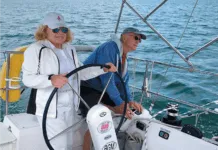Excerpted from: The Essential Knot Book for Boats, Fourth Edition
Handling Ropes and Lines
Not surprisingly, some consideration has to be given to the handling and care of all these high tech ropes.
Do:
- Keep them coiled or hanked neatly to prevent tangling
- Run them out carefully to avoid kinking and knotting.
- Coil laid ropes in clockwise loops (for right-hand lay) and use figures of eight for braids.
- Wash out salt, sand, grit and mud, which will otherwise chafe and destroy the fibers.
- Try to hang coiled or hanked ropes in a locker rather than dump them in an untidy heap.
- Protect all lines from chafe.
- Use eye splices rather than knotted loops for permanent or high load attachments.
- Use blocks whose sheaves have diameters in the ratio of at least 5:1 with that of the ropes they will carry.
- Ensure the rope fits comfortably into the groove of the sheave its passing round.
- Seal and whip ropes ends. Braided sheaths in particular fray very quickly.
Dont:
- Leave high tech lines exposed to high levels of ultraviolet light for long periods of time.
- Kink or twist any type of rope.
- Dont stand or walk on ropes and lines.
- Surge lines, particulary polypropylese ones, too fast around winches or cleats or theyll melt.
- Use rope stoppers that are likely to crush the rope’s core; some of the more exotic materials are prone to damage of this nature.
To learn more about the proper care of lines along with simple instructions and clear photos for tying the most useful knots for your boat, purchase The Essential Knot Book for Boats, Fourth Edition from Practical Sailor.


































